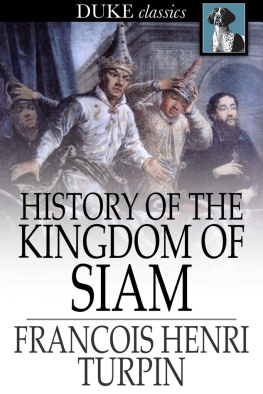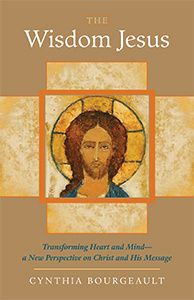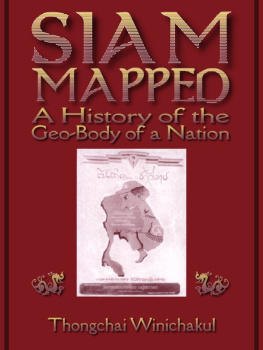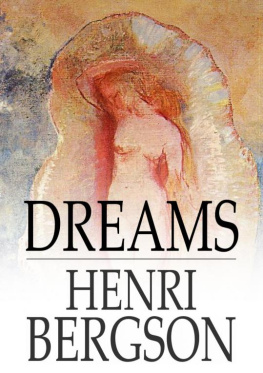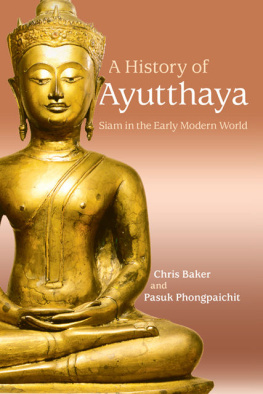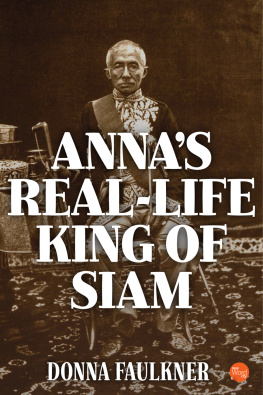Francois Henri Turpin - History of the Kingdom of Siam
Here you can read online Francois Henri Turpin - History of the Kingdom of Siam full text of the book (entire story) in english for free. Download pdf and epub, get meaning, cover and reviews about this ebook. year: 2018, publisher: Duke Classics, genre: History. Description of the work, (preface) as well as reviews are available. Best literature library LitArk.com created for fans of good reading and offers a wide selection of genres:
Romance novel
Science fiction
Adventure
Detective
Science
History
Home and family
Prose
Art
Politics
Computer
Non-fiction
Religion
Business
Children
Humor
Choose a favorite category and find really read worthwhile books. Enjoy immersion in the world of imagination, feel the emotions of the characters or learn something new for yourself, make an fascinating discovery.
- Book:History of the Kingdom of Siam
- Author:
- Publisher:Duke Classics
- Genre:
- Year:2018
- Rating:3 / 5
- Favourites:Add to favourites
- Your mark:
- 60
- 1
- 2
- 3
- 4
- 5
History of the Kingdom of Siam: summary, description and annotation
We offer to read an annotation, description, summary or preface (depends on what the author of the book "History of the Kingdom of Siam" wrote himself). If you haven't found the necessary information about the book — write in the comments, we will try to find it.
History of the Kingdom of Siam — read online for free the complete book (whole text) full work
Below is the text of the book, divided by pages. System saving the place of the last page read, allows you to conveniently read the book "History of the Kingdom of Siam" online for free, without having to search again every time where you left off. Put a bookmark, and you can go to the page where you finished reading at any time.
Font size:
Interval:
Bookmark:

And of the Revolutions that Have Caused the Overthrow of the Empire, Up to A.D. 1770
From a 1908 edition
ISBN 978-1-62013-737-6
Duke Classics
2014 Duke Classics and its licensors. All rights reserved.
While every effort has been used to ensure the accuracy and reliability of the information contained in this edition, Duke Classics does not assume liability or responsibility for any errors or omissions in this book. Duke Classics does not accept responsibility for loss suffered as a result of reliance upon the accuracy or currency of information contained in this book.
Turpin's History of Siam, published at Paris in the year 1771 consistsof two volumes, the first of which deals merely with the naturalHistory of Siam.
The present book is a translation of the second volume only, and is ofconsiderable interest owing to the fact that it is the only extantEuropean work dealing with the events leading up to and succeeding thefall of the old capital, Ayuthia.
We have no accounts of the compiler M. Turpin himself and thereforeare unable to give any account of his life or position.
The present volume falls into the following parts:
a. A short resum of the early history of Siam. Few names are given,and the accounts are somewhat vague. (Chapter 1).
b. An account of the reign of Phra Narai and his immediate successorsChapter 2-6. This portion has been compiled from the earlieraccounts of Forbin and La Loubre; but Tachard's remarks are nottreated as serious history.
c. A short chapter (Chapter 7) giving a somewhat vague account ofthe period intervening between the above and the next.
d. The events leading up to the fall of Ayuthia.
A description of the Burmese attack on the capital and of the earlyyears of the reign of Phya Tak (Chapter 8-11.) This forms the partof greatest interest.
e. A description of the Kingdoms bordering on Siam (Chapter 12-13).
Taken on the whole, the book gives a very fair and impartial account,but as the bulk of the information was derived from the CatholicMissionaries, a somewhat biassed view is taken of the religion of thecountries treated of.
The original has been carefully followed in the translation; here andthere a few sentences have been omitted for the reason that suchsentences are merely remarks of a moralizing nature on the part of M.Turpin himself, and have no connection whatever with the relation ofthe historical events.
B. O. CARTWRIGHT.
BANGKOK,
November, 1908.
Eastern despotism, which casts a blight on the soul and quenchespublic spirit, is the primary cause of all revolutions by which thepeople seek to ameliorate their condition by the overthrow of theirtyrants.
Every State in which there is One against All, has a defectiveconstitution, which causes it to pass in succession from greatness tohumiliation, from strength to weakness, and which, in its suicidalpolicy, awaits but a foreign invasion which will restore to thePeople, the enjoyment of their Rights.
The unstable and tottering thrones of Asia at last crumble away, andthe ambitious, arrogating to themselves the privileges of attemptingall things, are overwhelmed by their fall, and, reduce the weak toviolate everything in their despair.
The right of the strong is that of a footpad who plunders unarmedtravellers, and who, having enjoyed a period of immunity, dies underthe axe of the headsman. The Ruler who has the greater share in thebenefits of the Law does not recognise his advantages, and whenunwilling to extend them prefers to see himself surrounded bytrembling slaves who murmur in secret, and only await a leader tobecome rebels. The crude legislation of Siam has been the cause of allthe public ills of the nation. It knows neither the extent ofauthority nor the limits of obedience. This nation, indifferentregarding the choice of its masters, has received fetters from thehands of ambitious men who spurned the nation while coercing it.Invariably unfortunate, the people have no hope save in a futurerevolution, which will enslave them to a new tyrant insolentlybedecked with the imposing title of "Deliverer".
What can be the motive that prompts a despot to retain the privilegeof laying violent hands on the liberty and welfare of his subjects? Adespot who replaces natural rights by arbitrary power! He passes awaylike a torrent which leaves but the remembrance of its devastationbehind it. The Kings of Siam, invisible to their subjects madethemselves known merely by acts of authority. Thus they could neverinstil those tender feelings which are inspired by the presence of aKing who is both Father and Citizen.
I will not attempt to lift the veil which conceals the beginnings ofthis Kingdom. This people has never known the art of printing whichalone enshrines the virtues and shortcomings of those who preside overthe public destinies. Their historical records are founded only onvulgar fables, or on tradition sanctioned by priestly imposture, whichgives credence rather to the marvellous than to the simple truth. TheSiamese were unknown to us until the discovery of the Indies by thePortuguese, and it is from that period that we ought to reckon theirhistory.
Their first King, according to their vague records began to reign inB.C. 1444. He had forty successors up to the King who was reigning inA.D. 1546. All these Kings were of different families, who were inturn driven from the throne which they had seized, because, havingbecome despots, they were punished for the abuse of their power.
The proud and jealous spirits of a limited dependency ought, in thedegradation to which they have been reduced, to console themselveswith the hope that their degradation is but transitory, and that theirposterity shall be delivered from the chains which have weighed themdown. Rarely does tyranny transmit the fruits of its crimes to itsdescendants.
History has not given us the name of the King who reigned in 1550A.D., although the chief events of his reign have been chronicled. Itwas in this reign that the Kingdom of Siam was laid waste by theincursions of several neighbouring nations who carried fire and swordthroughout the towns and the country side. Thirty thousand innocentvictims were sacrificed to their ruthless vengeance, and this swarm ofwarriors seemed to prefer to lay waste the crops and to destroy thetowns rather than to conquer and govern them.
The King of Siam, alarmed at their progress, arose at the murmuringsof his people. He raised a large army. All those capable of bearingarms were summoned to the flag and those who were so cowardly as toexcuse themselves from fighting for their country, were threatenedwith the punishment of being burnt alive. Foreigners were bound bythis law.
At that time there were 130 Portuguese in the Kingdom, of whom 120were obliged to take up arms. The King believed himself to beinvincible, when he saw this handful of Europeans whom he regarded asso many heroes at his disposal.
A powerful army of 400,000 men including 70,000 non Siamese took thefield with the King at the head. The army was further reinforced onthe way by 100,000 men and 4000 elephants. We must regard thesenumbers as a gross exaggeration. It is true that the temperate natureof Eastern races renders the question of the food-supply an easymatter for the largest armies; but how could so great an army havebeen collected together in a country which boasts but few inhabitants.However we will set forth the facts as they have been handed down tous, and we can only question them by the light of their probability.
Font size:
Interval:
Bookmark:
Similar books «History of the Kingdom of Siam»
Look at similar books to History of the Kingdom of Siam. We have selected literature similar in name and meaning in the hope of providing readers with more options to find new, interesting, not yet read works.
Discussion, reviews of the book History of the Kingdom of Siam and just readers' own opinions. Leave your comments, write what you think about the work, its meaning or the main characters. Specify what exactly you liked and what you didn't like, and why you think so.

